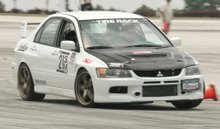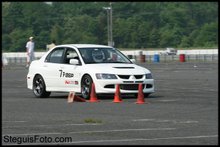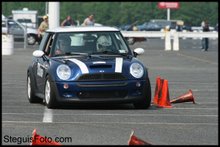there's a lot to autox.. what do they say? 90% driver, 5% car, and 5% crazy mojo? something like that. let's take a look at the 5% car because i can't help you on mojo, and well... driving is up to you! a confident driver = a fast driver, so the car part of the equation holds a little more weight.
all too often, i ask people what tire pressures people run in cars similar to mine. and it's something way off from what i've used successfully. then i ask, "how did you decide on that pressure?" most of the time, i get a blank stare. they're just stabbing in the dark! wtf! i guess i'm guilty of that in the past myself but i'm here to pass on my experience to you.
my point leads to this... our number one focus: MAXIMIZE FRONT GRIP. this is key. you don't want to take grip away from the rear to get a car to rotate with a monster rear-sway bar if you haven't addressed the front end. the same front end that's doing all the steering, braking, and in a lot of cases, putting the power down.
aight here's the dial-in skinny. get yourself a pyrometer. split the cost with a friend. or just buy someone lunch and borrow theirs. the infrared laser ones are so-so.. the real deal is a probe type. the super real deal is the longacre memory type that you see adil and jay using, and the same one you see me stealing from adil and jay!
measure the temps at 3 points across the tread.. outer, center, inner. you should do this IMMEDIATELY after a run, and focus on a single front tire. start with the one doing the most work. front left on a clockwise course.
write down the spread. you want a nice even gradient, with the inner temp slightly hotter than outer. 5-10 degrees hotter inside is a good rule of thumb. this is due to that pimpy camber you're running, and while not cornering, the inners having more contact with the ground, thus more friction = more heat. (toe settings will also affect these temps but we can get into that sometime later).
analyze the temps and adjust pressures accordingly. for example, say you read 125 inner, 150 center, 120 outer. guess what, you need to drop your tire pressure. in this case, you're gonna aim for 122.5 degrees. got it? and guess what, that pimpy camber setting is derived from these tire temps too! if your outers are 20 degress hotter then the inners.. then the tires are screaming... more camber! now of course if you have setup limitations (like in a stock class car) and can't adjust camber past a certain point, you still want to shoot for the most even temp spread.
we've been meticulous about car setup lately and the results show for our efforts. hopefully our approach is going to help you. autox is a game of thousandths.. this will help you drop that time. (i've lost by .001 seconds to adil after i stupidly pointed out where he can find some serious time in the course). but maybe i should've taken a longer dump that morning!
feel free to buy me lunch when your increased front grip has helped you get that trophy!
-dan
Subscribe to:
Post Comments (Atom)
















5 comments:
Dan, thanks for the info. Some great data on the site. I was the one who you instructed for the first run of the 4th heat on Sat... thanks for the great advice! I ended up dropping 1.3 seconds from my fastest run on my last run. Anyway, one thing I did before my last run was bleed about 3 psi out of my tires b/c I felt like I was driving better but my times just weren't getting better, and the car started feeling a little skatey. I haven't optimized the grip with a pyro (yet), but I think in my case letting out the pressure helped. In case anyone is curious... in think 45 psi on RE070 on stock-ish alignment is waaay too much...
glad i could help! you can definitely drive.. you just needed a little insight! great job
Good stuff Dan. I've been focusing on my front pressures mostly by measuring the amount of roll i'm getting on the tire. I should try reading the temps some time to see how far off I am. Do you do this for each run or just your last few runs?
Steve
Steve,
It's best to measure temps on all your runs. This way you can make a comparison based on your car feeling like it has lots of grip vs less grip and look at the temps for those runs. It'll tell you the temp range your tires are happy. The most scientific way to do that is also recording run data with MaxQ or another system since you can find actual peak and sustained G's and compare to your recorded temps and pressures and run times. It also helps with individual temps since most likely your runs will not be 100% consistent and you blow a corner here or there or simply overdrive. All those things will affect temps. It's a big vicious circle of data madness....that's the next installment for the blog...
thanks steve. i use this method more for initial setup. you can take it as far as you want though. for me, it's more of an early season, new site, or hardware change setup tool. when i switched tires over to neovas, the pyro and alignment gear came out. if you noticed, i was making big alignment changes at some of the events. jay and i are both mechanical engineers but he's way more tech than me! we'll see some cool writeups coming from jay soon
dan
Post a Comment